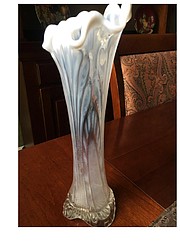DEAR HELAINE AND JOE:
This vase may have been a wedding gift to my mom when she was a young woman. She is now 83. She recently passed it on to me and I would like to know more about it.
— C. R.
DEAR C. R.: In her original letter, C.R. failed to mention how tall her vase happened to be. We wrote back and asked for the measurement because it is an important piece of information when we have to assign a monetary value. Sometimes vases such as this one can be very tall and are sometimes called “funeral vases” because they were often used to hold large bouquets
of flowers in funeral homes.
This particular piece, however, is just 11 inches tall, which means it was probably meant for home use. We feel the piece was made sometime in the 1910s or ’20s by any one of several glass companies working in Ohio or West Virginia. It is called opalescent glass, and believe it or not, it was made using a deadly poison that often figures in
old fashioned whodunits. Opalescent glass was made by
forming a parison (an unshaped mass of molten glass, sometimes called a “gather”) with either clear colorless or colored glass and coating it with a clear layer of glass containing bone ash and arsenic. The glass is then forced into a mold, either mechanically or by hand-blowing, which leaves raised areas on the body of the glass.
When the piece was removed from the mold, it was reheated and the raised areas turned milky white. The process produced a variety of designs that range from spots, dots and stars to stripes and floral decorations. The opalescence can also be found just as a border around the rim.
Opalescent glass was a very popular product made both in the United States and in Europe at the turn of the 20th century. It was made in vast quantities during the first quarter of the 20th century, and several modern glass companies revived it in the late 20th century. It can be found in a variety of background colors that range from blue and green to cranberry, canary yellow and clear.
Collectors tend to prefer the cranberry pieces, with blue, yellow and green glass following behind. Unfortunately, clear examples are generally the least desirable. The piece has a simple loop design with a white rim, and examples with this coloration and design are not difficult to find.
This is a piece of pressed opalescent glass that was probably an everyday part of C.R.’s mother’s home before she was born. Today, a vase such as this one retails in the $45 to $65 range and is much more important as a cherished heirloom.
Helaine Fendelman and Joe Rosson have written a number of books on antiques. Do you have an item you’d like to know more about? Contact them at Joe Rosson, 2504 Seymour Ave., Knoxville, TN 37917, or email them at treasures@knology. net. If you’d like your question to be considered for their column, please include a high-resolution photo of the subject with your inquiry.
